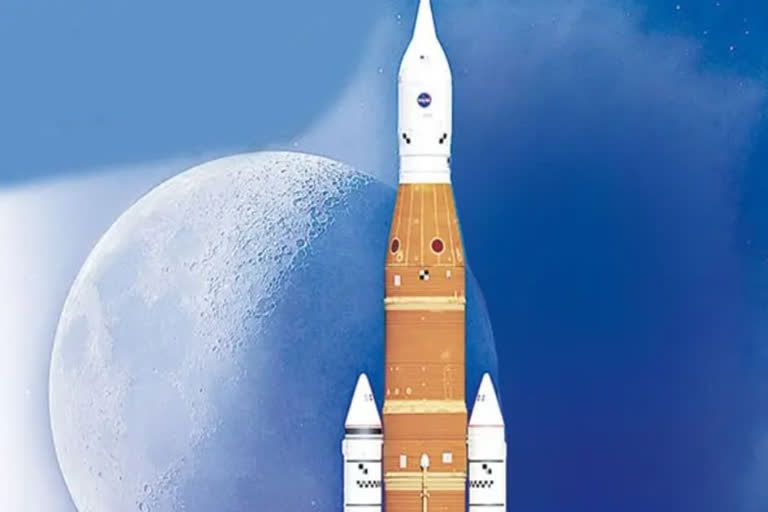Cape Canaveral (US): NASA cancelled Monday’s Artemis 1 launch because of fuel leaks, The Associated Press reported further stalling what would have been a historic moment in man's quest for the universe. After a long hiatus of 50 years, the launch would have been a massive step to sending a man again to the Moon. Instead of settling for nominal visits as in the past, the project focuses on the foundations for permanent habitation on the Moon. It will set the stage for in-depth research.
NASA said that its crews attempted to resolve two potential problems, “including an engine that isn’t conditioning properly and an apparent crack on an inner tank".
“Engineers are troubleshooting an issue conditioning one of the RS-25 engines (engine 3) on the bottom of the core stage,” NASA wrote in a blog post early Monday. “Launch controllers condition the engines by increasing pressure on the core stage tanks to bleed some of the cryogenic propellant to the engines to get them to the proper temperature range to start them. Engine 3 is not properly being conditioned through the bleed process, and engineers are troubleshooting.”
The post added: “Teams also are assessing what appears to be a crack in the thermal protection system material on one of the flanges on the core stage. The flanges are connection joints that function like a seam on a shirt, are affixed at the top and bottom of the intertank so the two tanks can be attached to it.”
The now-cancelled launch would have led humans to distant places in space. The most powerful rocket and spacecraft was scheduled to fly into the sky on this trip, conducted by NASA named Artemis-1. This spaceship orbiting the Moon was unmanned. Further experiments were to be carried out with human beings.
Why back to the Moon? In the 1960s, the United States undertook the Apollo project to conduct manned missions to the Moon. However, the superpower organised them to gain an upper hand over the Soviet Union rather than for scientific research. Manned trips to the Moon began in 1969 and ended in 1972. Astronauts never spent more than three days on the Moon on any mission.
- Now things have changed. There has been a growing interest in deep research beyond Earth's orbit. Researchers are preparing to establish colonies on the Moon, Mars and other celestial bodies.
- As part of this, NASA hopes to establish long-term habitats on the moon in the next 10 years. It wants to put astronauts there on a rotating basis. It wants to bring water and other resources from the surface of the Moon. It is hoped that these results will eventually help establish colonies on Mars. The success of Artemis-1 lays the foundations in this direction. The project mainly consists of a rocket named Space Launch System (SLS) and a capsule named Orion.
Orion: On top of the SLS is the Orion capsule. It can carry four astronauts. It can operate in lunar orbit for 21 consecutive days without needing to connect to another spacecraft. The crew module where the astronauts sit is crucial. It is designed to withstand the harsh conditions of space travel. The crew module has a service module built in Europe. It provides fuel and energy. It has solar panels.
- A mannequin sits in the commander's seat on Artemis-1. He wore a flight suit. How well it protects the astronaut from radioactivity will be investigated. Apart from this, two figures Helga and Zohar are also present in Orion. They are made of a material that simulates human tissue. They conduct research on topics related to long-distance space travel.
Also read: NASA moon rocket on track for launch despite lightning hits
The trip: The Artemis-1 mission will last six weeks. SLS will launch from the Kennedy Space Centre in Florida. After the specified time, the Orion will break away from the rocket. It goes into a 'translunar injection' trajectory towards the moon.
- Orion will take about a week to reach the Moon at a distance of 3.86 lakh km. It will first reach an orbit at an altitude of 100 km above the surface of the Moon.
- After that, it will enter into a distant orbit at a distance of 61,000 km. At that stage, it will be at a distance of 4.5 lakh km from Earth. Apollo didn't go that far on the mission. Astronauts in Orion at this stage can see the Earth and the Moon at the same time.
- Orion will use the Moon's gravity to return to Earth. This spaceship will enter the earth's atmosphere at a speed of 40,000 km per hour. At that stage, wind friction generates heat of 2,750 degrees Celsius on Orion. To withstand this, a special heat shield was installed on the spacecraft.
- The parachutes then deploy and slow down the Orion. The spacecraft will land in the Pacific Ocean near the coast of California. Defence personnel will retrieve it. It will happen on October 10 this year.
What is Artemis? Artemis is a Goddess in Greek mythology. Daughter of Zeus. Twin sister of Apollo. NASA chose this Goddess name because of the opportunity for female astronauts to be part of Artemis missions.
- Project cost: 9,300 crore dollars
- Cost of Artemis-1: $400 crore
- Distance travelled by Artemis-I in 42 days journey: 13 lakh km
- Humans, who have set foot on the Moon so far: 12 people
The most powerful rocket power: NASA has prepared a powerful rocket system called SLS to reach the Moon. It is smaller and thinner than the Saturn-5 rocket that carried the Apollo spacecraft that landed astronauts on the Moon less than 50 years ago. However, it delivers 15 per cent more power than the previous rocket.



